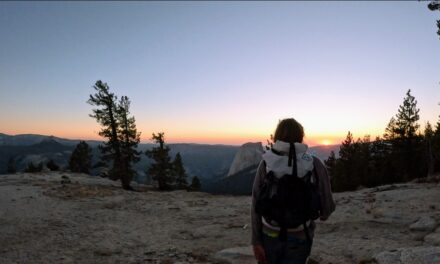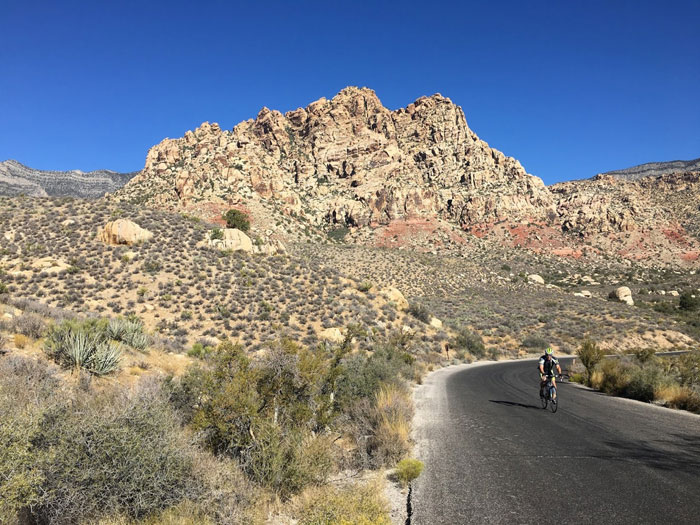- Tahoe’s Nevada Beach Tops the List of Hard-to-Book Campgrounds - 07/17/2024
- Cannabis Watershed Protection Program Cleans Up Illegal Grow Sites - 07/10/2024
- French Fire - 07/05/2024
Courting the comparison, couple explores two flanks on high, humble Lone Pine Peak
Story and photos by Bruce Willey
 It may be a stretch of the imagination to compare Lone Pine, California, with Chamonix, France. But if you look past the effigy of John Wayne on every motel wall downtown on the 395 strip, past the sage and Hollywood gunfights of the Alabama Hills, and straight up to the jagged aiguilles of the Sierra Crest, certain similarities come into focus.
It may be a stretch of the imagination to compare Lone Pine, California, with Chamonix, France. But if you look past the effigy of John Wayne on every motel wall downtown on the 395 strip, past the sage and Hollywood gunfights of the Alabama Hills, and straight up to the jagged aiguilles of the Sierra Crest, certain similarities come into focus.
And you’ll certainly not be the first to see it this way. When Clarence King was trying to locate and climb California’s highest peak in 1863, he dubbed all the mountains before him the “the New Alps.” Yes, despite the geographical embroidery, the imagination is most always supplely stretched in Lone Pine.
So it is then … Lone Pine, the poor man’s Chamonix. Where you can still buy a coffee for less than two dollars and the time to ponder what could have been had a téléphérique (aerial tramway) been built all the way to the top of Whitney as proposed in a 1926 Popular Mechanics article. Complete with a 40-room hotel on the summit, federal permits were granted for the project and 1,100 tons of steel were ready to be deployed for the engineering feat to rival France’s Téléphérique de l’Aiguille du Midi. “The loftiest peak in the Continental United States will be accessible without climbing,” the article stated. So much for the pesky trail quotas and sweaty socks.
So with a spell of welcome good weather after an unseasonably turbulent June and July, we turned our focus to the Lone Pine region’s namesake peak. Coming in at a few hairs under 13,000 feet, Lone Pine Peak is far from the highest summit in this, the loftiest stretch of the High Sierra. Yet because it juts haughtily out into the Owens Valley, rising some 7,000 feet off the desert floor, Lone Pine Peak seems to tower over the less humble fourteener’s behind it—namely Langely, Muir, Keeler, Whitney, and Russell.
Being a climber of moderate ability and broad sensibility, I used to scoff at Lone Pine Peak’s North Ridge and its measly 5.4 rating. With its gentle angle rising from the sage to summit, the ridge is said to be a good route for the “aspiring alpinist,” as one poster on an Internet forum put it. Better to save the route for when I’m old and infirm, I thought, when the sunset years take me back to hip-belays and Vibram-soled boot affairs.
But midway through the route, pulling another nefarious 5.9 plus move, I was glad I didn’t.
A short approach on the Meysen Lakes trail brings the missus and I, her wedded climbing partner, to a tidy camp complete with granite couch to admire the Sierra shadow creeping over the Owens Valley and up the Inyo Range. How quickly we jump to conclusions that we are home, staking the mosquito-fascist barrier (aka, the tent) with all the care of a multi-millionaire building a house above the fray. We sleep well with the knowledge we are rich and a day of easy climbing awaits us.
Alpine start be-damned. Chance of thunderstorm almost nil. We sleep through first light, second light, even third light, sleeping bags spread open to salacious possibility. Of all my climbing partners, bless their black hearts, ‘tis best to be married to one. Adds a certain legitimacy to being tied into the same rope, not to mention the wonderment of mimicking marmot mating rituals in the morning.
With this whole and fortifying start of the day complete we decide we should probably get to the task of climbing. The ridge proper begins after a long scree and talus production, allowing our loins to unrattle before tying to a thin alpine 50-meter cord. “Glad to have the rock shoes,” I say to Caroline while heading up the first buttress. “This ain’t 5.4 for sure.”
There are many ways to ascend, but we try to stay true as we can to the ridge itself. Exposed and airy in places, it feels like we are riding a giant, prehistoric tail. The whole Whitney Zone comes barreling into view. If only Clarence King had the maps and foresight to climb this peak in 1864 instead of Mt. Tyndall. He would have surely seen his prize right away and climbed the mountain he kiss-ass named after his boss at the California Geological Survey, Josiah Whitney. Instead, in 1873, some fishermen from Lone Pine took the prize as the first to summit the highest peak in the contiguous United States, and for eight years it was named Fisherman’s Peak, before the U.S. Geological Survey ruled otherwise, certifying that King had made an honest mistake.
By mid-afternoon, after winding around gendarmes and blocks and buttresses, we at last see the summit. Tantalizingly close, as always, but still far away. More 5.9, even some 5.10 thrown in for good measure, which has me wishing we’d brought a larger rack. “This climb is stout,” I say.
“And long,” says Caroline.
But at long last we reach the summit, our feet happy to be out of rock shoes, our minds freed from the dangling exposure. The view is aerial, worthy of lingering on the summit for just a few more minutes before making tracks down the sandy backside. To the south, the summit drops into Tuttle Canyon sporting walls the size and grandeur of Yosemite. One ridge is not enough to understand this fine peak. And so we make plans to explore Lone Pine Peak’s less visited flank.
…………………………………………………
 The Red Baron Tower on the steep southern flank of Lone Pine Peak had been on my mind for a long time. But with the recent passing of Bruce Binder—aka Brutus of Whyd—a few weeks before (he died tragically, June 12, in an auto accident on his way to climb Castle Rock Spire in Sequoia National Park) we decide to pay tribute to his and Craig Harris’ route, Milktoast Chimney.
The Red Baron Tower on the steep southern flank of Lone Pine Peak had been on my mind for a long time. But with the recent passing of Bruce Binder—aka Brutus of Whyd—a few weeks before (he died tragically, June 12, in an auto accident on his way to climb Castle Rock Spire in Sequoia National Park) we decide to pay tribute to his and Craig Harris’ route, Milktoast Chimney.
Passing the abandoned Stone House Ashram that Warren Harding used as headquarters for his “Lower Sierra Eating, Drinking, and Farcing Society,” we are soon lost and sweating through an endless sea of manzanita. Though I have nothing against the red-stemmed plant from afar, once in the thickets—in shorts no less—I’m overcome with the ability to curse like a Warren jacked up on a gallon jug of Modesto’s finest. I break “trail” and behind me my German Frau utters the most vile words she can find in her native tongue. Soon enough I am speaking her language too.
By nightfall we find a climber’s camp under the lodgepoles, complete with fire ring and wood bench. Another million-dollar view, this time facing up the huge granite faces of Lone Pine Peak in the moonlight. If fireside spirits could be heard this would be the place to hear them. Binder, Harding, Galen Rowell, all well-known climbers who realized the potential of these walls, camped here. So we light a very small fire in their honor and turn in under the stars.
First light, sleeping bags zippered shut, we’re up. Despite the 5.8 rating of the route, we know Binder routes have a reputation. Brutus of Whyd, like Chuck Pratt, ate off-widths for breakfast. And by the second pitch I find myself groveling up one of the most indecent, slickest wide cracks of my climbing career—if you can call it that. Not quite wide enough to fit your body into and too wide to kick-start with either end of my shoes, I feel as though I’ll be rudely spit out into the air like a lump of chaw.
But soon the route eases off some, meandering straight up the chimney. Sometimes we find ourselves caving deep inside where sunlight never shines; other times, wriggling through the outside of the chimney like human Cams. And though the red granite-topped tower doesn’t reach the Lone Pine Peak’s proper summit, we are wholly satisfied with the fine route when we top out.
Breaking camp we head down, assaulted once more by the fierce manzanita. Yet we know this hardship is only a reminder that we are solidly in the poor man’s Chamonix. That instead of a téléphérique whisking us down into civilization, we are alone below the walls of Lone Pine Peak, making our own way down this forgotten canyon. And we are heading home.
—————————————–
Bruce Willey is a freelance writer slash photographer with an emphasis on slash. Dividing his time between Big Pine, CA, Berlin, Germany, and Hotlanta, Georgia, Willey has been published in most of the American climbing mags, but claims ASJ is his favorite. See more of his work at www.brucewilley.com













